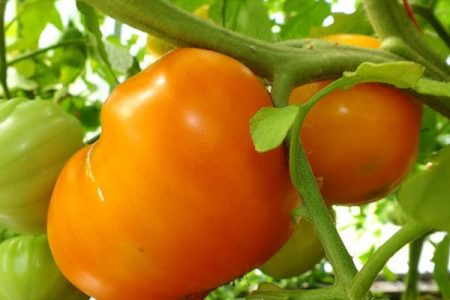 Among the many varieties of Orange Heart, tomatoes stand out not only in shape and color, but also in two other, important characteristics. The first - they can be grown quite safely in all possible regions of the country, the second - this variety is recommended for allergy sufferers as safe.
Among the many varieties of Orange Heart, tomatoes stand out not only in shape and color, but also in two other, important characteristics. The first - they can be grown quite safely in all possible regions of the country, the second - this variety is recommended for allergy sufferers as safe.
Characteristic
Yes, an Orange (or Bull) heart can really be grown in any of the many regions of the country. It's true. Variety of tomatoes attributed to hybrid, early ripening, because from the moment of planting the seeds and until the first fruits ripen, usually takes about 125 - 130 days. The bushes are indeterminate, which means they do not have a specific growth boundary. The bushes are tall, they have medium leafy, they are not standard.
Liskin's nose (aka Orange Heart) grows calmly both on open, garden soil, and inside greenhouses. The height of the bushes is about 150-180 cm, there are also 2 m. Tomatoes are highly resistant to most diseases (alas, the plants also have their own diseases, they even have cancer), but they often suffer from the scourge of vegetable late blight. One bush can produce up to 5 kg of beautiful, ripe fruits, if grown in a greenhouse, creating favorable conditions, taking maximum care, you can harvest up to 20 kg.
Fruit
Any photo of tomatoes will show the characteristic shape of the Bull's heart - heart-shaped with a pleasant, bright orange color. Weight 150 g, but large, 400 g fruits are found. Tomatoes have few seeds inside, dry matter is kept at an average level, and the number of internal chambers remains average. This simplifies the operation of tomatoes in cooking. They are easier to chop in salads, keep their shape.
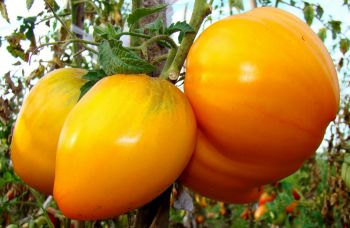
A small minus - Liskin nose can not be stored for a long time, it deteriorates.
The main one can say the specialization of this variety, as the reviews say, is the use in salads or fresh.
Pros and cons
Any characteristic of a tomato will include strengths with a defect in the variety. Without this, the description will obviously turn out to be incomplete, because it is studied not only by consumers, but also by gardeners, serious producers who choose crops for mass cultivation. Certain criteria are important to them.
Liskin's nose (they’re also Bull’s heart), what are the advantages:
• Great taste, great view, with a pleasant, bright color;
• Drought tolerant (this is during the period of maturation and growth);
• Give a good harvest (with proper care);
• They can be grown in almost any of the regions of the Russian Federation;
• Large-fruited.
• A beautiful view is noted and photos of tomato varieties. What are the disadvantages?
• Subject to late blight;
• Few approaches to conservation.
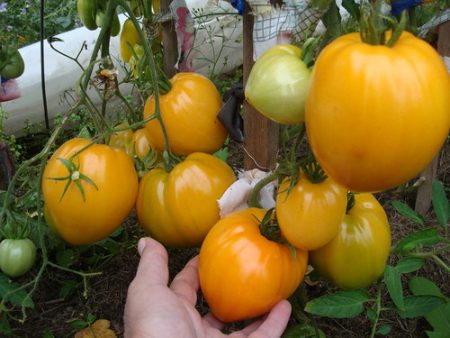
Apparently, more than just such a variety is used by culinary specialists who eat immediately, without forming reserves. Large-fruited not everyone likes, because large fruits are more difficult to distribute by quantity per dish, when one is not enough, and two are already many. Here, unpretentiousness to the climate, the composition of the soil is a great plus for any kind of vegetables. So the gardener can safely plant a Bull’s heart without worrying about the “surprises” of nature and getting a good tomato crop.
After all, the variety is drought-resistant, if you make a good garter, then you can not be afraid of strong winds. With other, more demanding varieties more difficult. Either change the soil by buying or bringing in another, or plant only in a greenhouse. Moreover, not all gardeners have spacious greenhouses. Most prefer to plant on the example of their ancestors - simply, on the ground of their site. Of course, they need to select only unpretentious varieties so that the work will pay off with a good harvest.
Features
“Bull’s heart” (they are also the Liskin nose) form inflorescences immediately above the first leaves. And one brush can contain 5-6 whole fruits. The very fruits of one brush differ in their shape and weight. Large ones usually grow from below, smaller and medium ones grow from above. It is as if nature takes care of the hands, having equal weight.
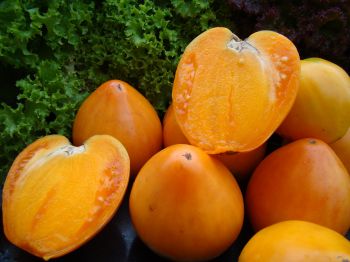
Growing
The process of growing “Bull's Heart” is considered quite time-consuming. First, seeds selected for seedlings are sown around the beginning of March, when the snow has not yet melted. They need to be placed in 3 cm pits on seedlings or portable beds (usually for seedlings gardeners make a dozen separate places or several common, long from improvised materials). Even before transplanting, all seeds must be carefully treated with a prepared solution of potassium permanganate, then washed with water. After waiting for the formation of two leaves of the seedling, it is time to start diving.
Important: do not forget about complex fertilizers, then about 1.5-2 weeks before planting the finished seedlings, conduct them hardening.
If there is no heating in the greenhouse, then tomato seedlings it is worth planting by early May (or a landing is planned on the ground). By May, the snow just melts, the long-awaited warming will come. The general landing will be at the end of May - beginning at June. It is worth clarifying auspicious days by checking the lunar calendar. It indicates the specific type of vegetables or fruits for planting, the numbers for all months. For gardeners, the Lunar calendar is a real crib. If plants are planted in a good, favorable period, this increases the chances of getting a rich harvest then.
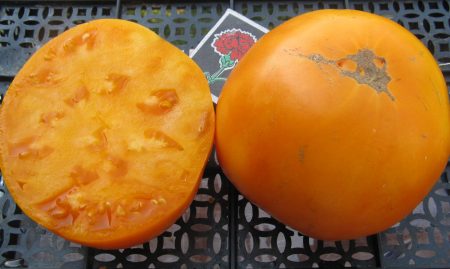
Places should be arranged as: 1 square meter - not more than 5 separate plants. Otherwise, then it will be crowded. Imagine tall, up to 1.8 m bushes. This variety needs to be tied up and subsequent pinching. Only 1 stalk needs to be formed. To stop the growth of the bush in time, you need to pinch by the 28-30th dates already in July.
Diseases, pests
Alas, the scourge of vegetables - late blight threatens the “Bull’s heart”. To cope, you need to carefully ventilate your greenhouse, check tomato bushes. Loosen regularly, do not forget about weeding the beds, even when the bushes are already large. By the way, examinations and spraying will help not only against late blight, but will also become an excellent general prevention.
Important: love your plants, every bush. They feel the attitude of the owner and with good, warm care they will grow strong, bear fruit well. This advice applies to growing any crop.
By the way, try not to plant tomatoes in the neighborhood, for example, with potatoes or other nightshade crops. Then the threat of late blight is significantly reduced.
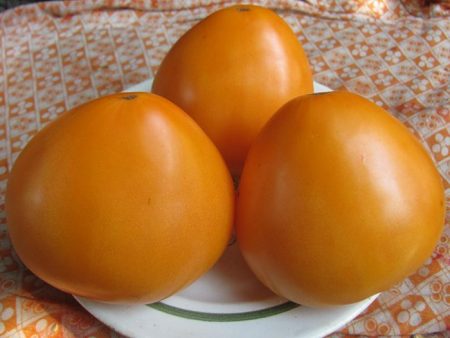
If late blight is already manifested, tincture of garlic or from fermented mushrooms will help. Start it with a sprayer and regularly treat diseased plants. Fungicidal drugs also help. In order to avoid unpleasant visits from pests, often process tomatoes and insecticides.
Feeding is about 3-4 times in total for the growing period. This is a complex fertilizer, alternated with the usual mullein solution.
Recommended:Gardener lunar sowing calendar for May 2017
Side stepsons need to be removed on time, lower leaves too. When flowering begins, gently pinch off the deformed, also small flowers from the brushes. This procedure becomes a stimulant for the formation of ovaries, and the fruits grow larger.
Important: the fruits may not be very suitable for canning, but they tolerate transportation well and are stored too.




 Low-growing tomatoes, without pinching: 5 of the most delicious varieties
Low-growing tomatoes, without pinching: 5 of the most delicious varieties Why tomato seedlings grow poorly
Why tomato seedlings grow poorly We grow a tomato in a shell
We grow a tomato in a shell Growing tomatoes without watering according to the method of Kazarin
Growing tomatoes without watering according to the method of Kazarin